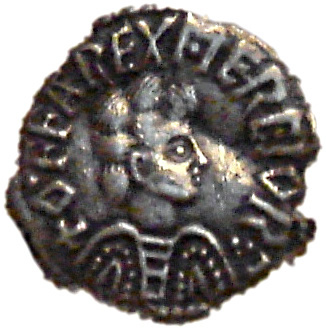 The best known relic associated with Offa's time is Offa's Dyke, a great earthen barrier that runs approximately along the border between England and Wales. It is mentioned by the monk Asser in his biography of Alfred the Great: 'a certain vigorous king called Offa ... had a great dyke built between Wales and Mercia from sea to sea'. The dyke has not been dated by archaeological methods, but most historians find no reason to doubt Asser's attribution. Early names for the dyke in both Welsh and English also support the attribution to Offa. Despite Asser's comment that the dyke ran 'from sea to sea', it is now thought that the original structure only covered about two-thirds of the length of the border: in the north it ends near Llanfynydd, less than five miles (8 km) from the coast, while in the south it stops at Rushock Hill, near Kington in Herefordshire, less than fifty miles (80 km) from the Bristol Channel. The total length of this section is about 64 miles (103 km). Other earthworks exist along the Welsh border, of which Wat's Dyke is one of the largest, but it is not possible to date them relative to each other and so it cannot be determined whether Offa's Dyke was a copy of or the inspiration for Wat's Dyke.
The best known relic associated with Offa's time is Offa's Dyke, a great earthen barrier that runs approximately along the border between England and Wales. It is mentioned by the monk Asser in his biography of Alfred the Great: 'a certain vigorous king called Offa ... had a great dyke built between Wales and Mercia from sea to sea'. The dyke has not been dated by archaeological methods, but most historians find no reason to doubt Asser's attribution. Early names for the dyke in both Welsh and English also support the attribution to Offa. Despite Asser's comment that the dyke ran 'from sea to sea', it is now thought that the original structure only covered about two-thirds of the length of the border: in the north it ends near Llanfynydd, less than five miles (8 km) from the coast, while in the south it stops at Rushock Hill, near Kington in Herefordshire, less than fifty miles (80 km) from the Bristol Channel. The total length of this section is about 64 miles (103 km). Other earthworks exist along the Welsh border, of which Wat's Dyke is one of the largest, but it is not possible to date them relative to each other and so it cannot be determined whether Offa's Dyke was a copy of or the inspiration for Wat's Dyke.
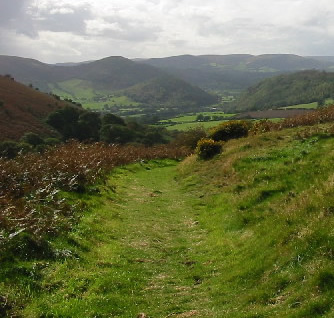 The construction of the dyke suggests that it was built to create an effective barrier and to command views into Wales. This implies that the Mercians who built it were free to choose the best location for the dyke. There are settlements to the west of the dyke that have names that imply they were English by the 8th century, so it may be that in choosing the location of the barrier the Mercians were consciously surrendering some territory to the native Britons. Alternatively it may be that these settlements had already been retaken by the Welsh, implying a defensive role for the barrier. The effort and expense that must have gone into building the dyke are impressive, and suggest that the king who had it built (whether Offa or someone else) had considerable resources at his disposal. Other substantial construction projects of a similar date do exist, however, such as Wat's Dyke and Danevirke, in what is now Germany as well as such sites as Stonehenge from millennia earlier. The dyke can be regarded in the light of these counterparts as the largest and most recent great construction of the preliterate inhabitants of Britain.
The construction of the dyke suggests that it was built to create an effective barrier and to command views into Wales. This implies that the Mercians who built it were free to choose the best location for the dyke. There are settlements to the west of the dyke that have names that imply they were English by the 8th century, so it may be that in choosing the location of the barrier the Mercians were consciously surrendering some territory to the native Britons. Alternatively it may be that these settlements had already been retaken by the Welsh, implying a defensive role for the barrier. The effort and expense that must have gone into building the dyke are impressive, and suggest that the king who had it built (whether Offa or someone else) had considerable resources at his disposal. Other substantial construction projects of a similar date do exist, however, such as Wat's Dyke and Danevirke, in what is now Germany as well as such sites as Stonehenge from millennia earlier. The dyke can be regarded in the light of these counterparts as the largest and most recent great construction of the preliterate inhabitants of Britain.
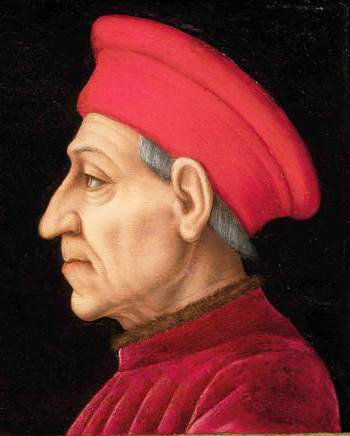 Cosimo de' Medici was born in Florence to Giovanni di Bicci de' Medici and his wife Piccarda Bueri on 10 April 1389. At the time, it was customary to indicate the name of one's father in one's name for the purpose of distinguishing the identities of two like-named individuals; thus Giovanni was the son of Bicci, and Cosimo's name was properly rendered Cosimo di Giovanni de' Medici. He was born along with a twin brother Damiano, who survived only a short time. The twins were named after Saints Cosmas and Damian, whose feast day was then celebrated on 27 September; Cosimo would later celebrate his own birthday on that day, his 'name day', rather than on the actual date of his birth. Cosimo also had a brother Lorenzo, known as 'Lorenzo the Elder', who was some six years his junior and participated in the family's banking enterprise.
Cosimo de' Medici was born in Florence to Giovanni di Bicci de' Medici and his wife Piccarda Bueri on 10 April 1389. At the time, it was customary to indicate the name of one's father in one's name for the purpose of distinguishing the identities of two like-named individuals; thus Giovanni was the son of Bicci, and Cosimo's name was properly rendered Cosimo di Giovanni de' Medici. He was born along with a twin brother Damiano, who survived only a short time. The twins were named after Saints Cosmas and Damian, whose feast day was then celebrated on 27 September; Cosimo would later celebrate his own birthday on that day, his 'name day', rather than on the actual date of his birth. Cosimo also had a brother Lorenzo, known as 'Lorenzo the Elder', who was some six years his junior and participated in the family's banking enterprise.
In the realm of philosophy, Cosimo, influenced by the lectures of Gemistus Plethon, supported Marsilio Ficino and his attempts at reviving Neo-Platonism. Cosimo commissioned Ficino's Latin translation of the complete works of Plato (the first ever complete translation) and collected a vast library that he shared with intellectuals such as Niccola de' Niccoli and Leonardo Bruni. He also established a Platonic Academy in Florence in 1445. He provided his grandson Lorenzo de' Medici with an education in the studia humanitatis. Cosimo certainly had an influence on Renaissance intellectual life, but it was Lorenzo who would later be deemed to have been the greatest patron.
T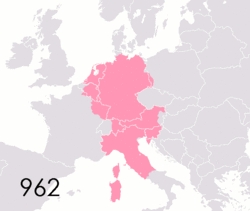 he Holy Roman Empire (Latin: Sacrum Romanum Imperium; German: Heiliges Römisches Reich) was a multi-ethnic complex of territories in Western and Central Europe that developed during the Early Middle Ages and continued until its dissolution in 1806 during the Napoleonic Wars. The largest territory of the empire after 962 was the Kingdom of Germany, though it also came to include the neighboring Kingdom of Bohemia, the Kingdom of Burgundy, the Kingdom of Italy, and numerous other territories.
he Holy Roman Empire (Latin: Sacrum Romanum Imperium; German: Heiliges Römisches Reich) was a multi-ethnic complex of territories in Western and Central Europe that developed during the Early Middle Ages and continued until its dissolution in 1806 during the Napoleonic Wars. The largest territory of the empire after 962 was the Kingdom of Germany, though it also came to include the neighboring Kingdom of Bohemia, the Kingdom of Burgundy, the Kingdom of Italy, and numerous other territories.
On 25 December 800, Pope Leo III crowned the Frankish king Charlemagne as Emperor, reviving the title in Western Europe, more than three centuries after the fall of the earlier ancient Western Roman Empire in 476. The title continued in the Carolingian family until 888 and from 896 to 899, after which it was contested by the rulers of Italy in a series of civil wars until the death of the last Italian claimant, Berengar I, in 924. The title was revived again in 962 when Otto I was crowned emperor, fashioning himself as the successor of Charlemagne and beginning a continuous existence of the empire for over eight centuries. Some historians refer to the coronation of Charlemagne as the origin of the empire, while others prefer the coronation of Otto I as its beginning. Scholars generally concur, however, in relating an evolution of the institutions and principles constituting the empire, describing a gradual assumption of the imperial title and role.
The exact term 'Holy Roman Empire' was not used until the 13th century, but the concept of translatio imperii, the notion that he—the sovereign ruler—held supreme power inherited from the ancient emperors of Rome, was fundamental to the prestige of the emperor. The office of Holy Roman Emperor was traditionally elective, although frequently controlled by dynasties. The mostly German prince-electors, the highest-ranking noblemen of the empire, usually elected one of their peers as 'King of the Romans', and he would later be crowned emperor by the Pope; the tradition of papal coronations was discontinued in the 16th century.
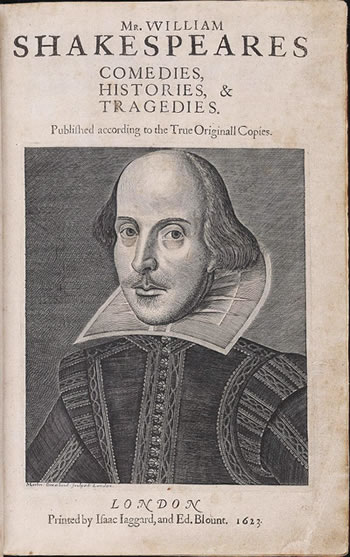 Mr. William Shakespeare's Comedies, Histories, & Tragedies is the 1623 published collection of William Shakespeare's plays. Modern scholars commonly refer to it as the First Folio. The First Folio is considered one of the most influential books ever published in the English language.
Mr. William Shakespeare's Comedies, Histories, & Tragedies is the 1623 published collection of William Shakespeare's plays. Modern scholars commonly refer to it as the First Folio. The First Folio is considered one of the most influential books ever published in the English language.
The contents of the First Folio were compiled by John Heminges and Henry Condell; the members of the Stationers Company who published the book were the booksellers Edward Blount and the father/son team of William and Isaac Jaggard. William Jaggard has seemed an odd choice by the King's Men because he had published the questionable collection The Passionate Pilgrim as Shakespeare's, and in 1619 had printed new editions of 10 Shakespearean quartos to which he did not have clear rights, some with false dates and title pages (the False Folio affair). Indeed, his contemporary Thomas Heywood, whose poetry Jaggard had pirated and misattributed to Shakespeare, specifically reports that Shakespeare was 'much offended with M. Jaggard (that altogether unknown to him) presumed to make so bold with his name.'
Some Shakespeare directors and theatre companies producing Shakespeare believe that while modern editions of Shakespeare's plays, which are heavily edited and changed, are more readable, they remove possible actor cues found in the Folio, such as capitalization, different punctuation and even the changing or removal of whole words. Among the theatre companies that have based their production approach upon use of the First Folio was the Riverside Shakespeare Company, which, in the early 1980s, began a studied approach to their stage productions relying upon the First Folio as their textual guide. In the 1990s, the First Folio was reissued in a paperback format more accessible to the general public.